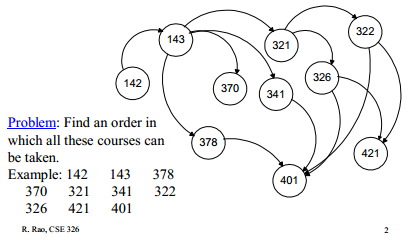Question
Topological ordering of a directed graph is a linear ordering of its vertices such that for every directed edge uv from vertex u to vertex v, u comes before v in the ordering.
A topological ordering is possible if and only if the graph has no directed cycles, that is, if it is a directed acyclic graph (DAG).
Analysis
Canonical application of toposort is to schedule tasks with dependency (project management etc.) It’s also used for computing formulas, logic synthesis, order of compilation (‘make’ command) and data serialization.

Solution
The usual algorithms have linear run-time, i.e. O(V + E).
First step is to find a list of “start nodes” which have no incoming edges. Then insert them into a set S and delete it. At least one such node must exist in an directed acyclic graph. From a university lecture.
From Wiki:
L ← Empty list that will contain the sorted elements
S ← Set of all nodes with no incoming edges
while S is non-empty do
remove a node n from S
add n to tail of L
for each node m with an edge e from n to m do
remove edge e from the graph
if m has no other incoming edges then
insert m into S
if graph has edges then
return error (graph has at least one cycle)
else
return L (a topologically sorted order)
If the graph is a DAG, a solution will be contained in the list L (the solution is not necessarily unique). Otherwise, the graph must have at least one cycle and therefore a topological sorting is impossible.
Code
The solution comes from here.

public class Graph {
private int vertices;
private Set<Node> nodes = new HashSet<Node>();
public Graph(int vertices) {
this.vertices = vertices;
}
public void addVertex(Node node) {
this.nodes.add(node);
}
public Set<Node> topologicalSort() {
Queue<Node> q = new LinkedList<Node>();
Set<Node> topoSort = new LinkedHashSet<Node>();
int vertexProcessesCtr = 0;
for (Node m : this.nodes) {
vertexProcessesCtr = addToQueue(m, topoSort, vertexProcessesCtr, q);
}
while (!q.isEmpty()) {
Node m = q.poll();
for (Node child : m.getAdjacenctNode()) {
int indeq = child.getInDegree() - 1;
child.setInDegree(indeq);
vertexProcessesCtr = addToQueue(child, topoSort,
vertexProcessesCtr, q);
}
}
if (vertexProcessesCtr > this.vertices) {
System.out.println();
}
return topoSort;
}
private int addToQueue(Node node, Set<Node> topoSort, int vertexProcess,
Queue<Node> q) {
if (node.getInDegree() == 0) {
q.add(node);
topoSort.add(node);
return vertexProcess + 1;
}
return vertexProcess;
}
public static void main(String[] args) {
Graph g = new Graph(8);
Node TEN = new Node("10");
Node ELEVEN = new Node("11");
Node TWO = new Node("2");
Node THREE = new Node("3");
Node FIVE = new Node("5");
Node SEVEN = new Node("7");
Node EIGHT = new Node("8");
Node NINE = new Node("9");
SEVEN.AdjacenctNode.add(ELEVEN);
ELEVEN.inDegree++;
SEVEN.AdjacenctNode.add(EIGHT);
EIGHT.inDegree++;
FIVE.AdjacenctNode.add(ELEVEN);
ELEVEN.inDegree++;
THREE.AdjacenctNode.add(EIGHT);
EIGHT.inDegree++;
THREE.AdjacenctNode.add(TEN);
TEN.inDegree++;
ELEVEN.AdjacenctNode.add(TEN);
TEN.inDegree++;
ELEVEN.AdjacenctNode.add(TWO);
TWO.inDegree++;
ELEVEN.AdjacenctNode.add(NINE);
NINE.inDegree++;
EIGHT.AdjacenctNode.add(NINE);
NINE.inDegree++;
g.nodes.add(TWO);
g.nodes.add(THREE);
g.nodes.add(FIVE);
g.nodes.add(SEVEN);
g.nodes.add(EIGHT);
g.nodes.add(NINE);
System.out.println("Now calling the topologial sorts");
Set<Node> result = g.topologicalSort();
for (Node node : result) {
System.out.println(node.data + " ");
}
}
}
class Node {
public String data;
public int dist;
public int inDegree;
LinkedList<Node> AdjacenctNode = new LinkedList<Node>();
public void addAdjNode(final Node Child) {
AdjacenctNode.add(Child);
Child.inDegree++;
}
public Node(String data) {
super();
this.data = data;
}
public int getInDegree() {
return inDegree;
}
public void setInDegree(int inDegree) {
this.inDegree = inDegree;
}
public LinkedList<Node> getAdjacenctNode() {
return AdjacenctNode;
}
}